Ramadan Kareem! The holy month of Ramadan is here! For 30 days each year, Muslims all across the world dedicate themselves to prayer, acts of charity, and reading the Holy Qur’an, and many will abstain from eating, drinking and smoking between dawn and dusk each day.
This week, we’ve put together an introduction to the month of Ramadan, from key terminology to the festive treats that are served. If you’d like to learn more about Ramadan, here’s some of the most important aspects of the month to know about, and if you’re learning Arabic we’re sharing all the Ramadan vocabulary you’ll need!
Ramadan Kareem! | !رمضان كريم
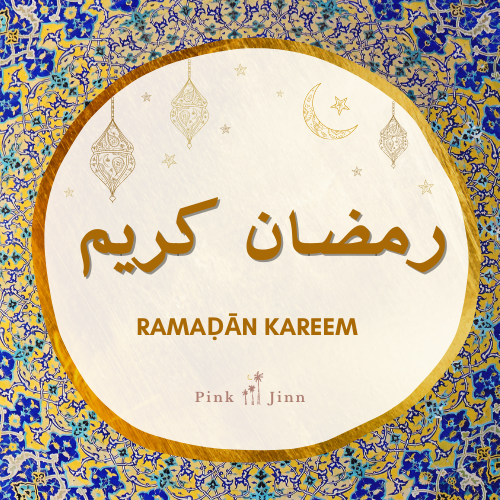
Ramadan is the name of a month in the Islamic calendar in which the Holy Qur’an was revealed to the Prophet Mohammed (pbuh).
Muslims across the world spend the month focusing on their faith through prayer. Ramadan culminates in the beautiful celebration of Eid al-Fitr, which marks the end of the month of fasting.
If you aren’t celebrating yourself, you can wish any of your Muslim friends, family or neighbours Ramadan Kareem (Have a generous Ramadan) or Ramadan Mubarak (Have a blessed Ramadan)!
Al Qamr | The Moon | القمر
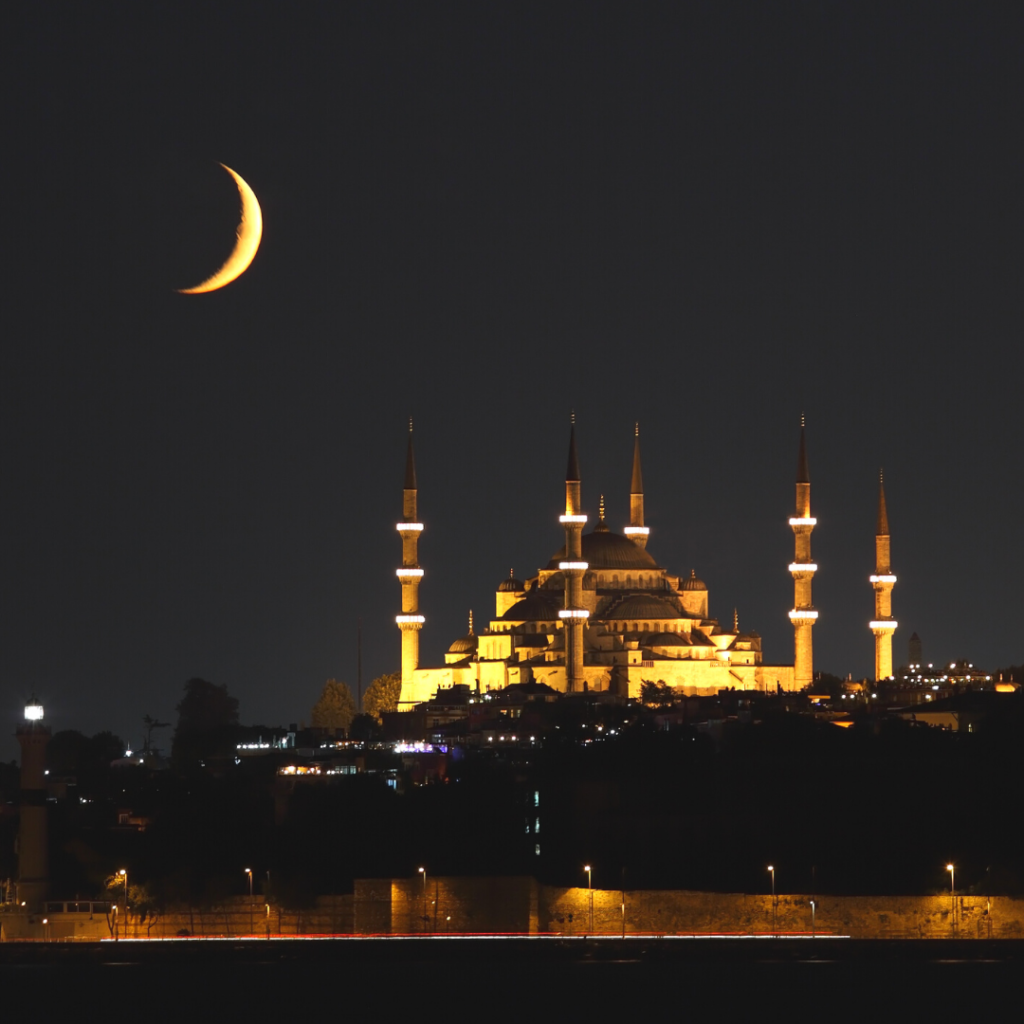
The moon plays a key role in the month of Ramadan because the Islamic, or Hijri, calendar is lunar.
This means that the month of Ramadan doesn’t coincide with a specific date in the Gregorian calendar used in the West. It begins between 10 and 12 days earlier each year (in Gregorian terms), rotating through the seasons.
Hilāl | Crescent Moon | هِلال
The beginning of the holy month of Ramadan is declared only when the crescent moon of the new month is sighted. Not all schools of thought agree exactly about when the crescent moon is sighted. Weather conditions can impact visibility, and so some countries can announce the start of Ramadan a day later than others.
Tamr | Dates | تمر
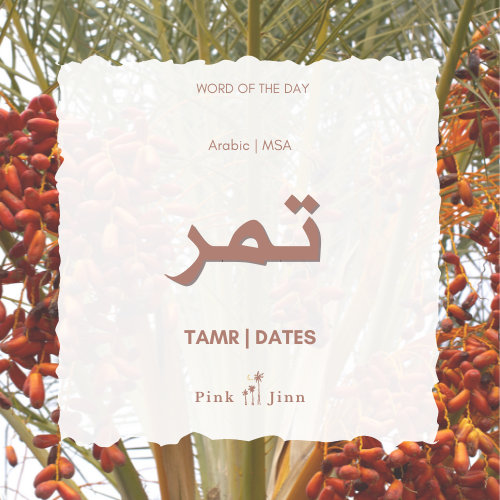
Dates aren’t just delicious, they’re a big part of Ramadan for many Muslims. The Prophet Mohammed himself (pbuh) used to break his fast with three dates, and this remains a common custom all across the Islamic world. If you break your fast in a Muslim home or at a restaurant, you will usually be offered dates and water before the main ifṭar dishes.
To keep up with this huge demand, dates are grown in massive quantities all across the Middle East, but Egypt is the top producer worldwide and exports more than a million tonnes of dates every year!
Ifṭār | The Breaking of the Fast | إفطار
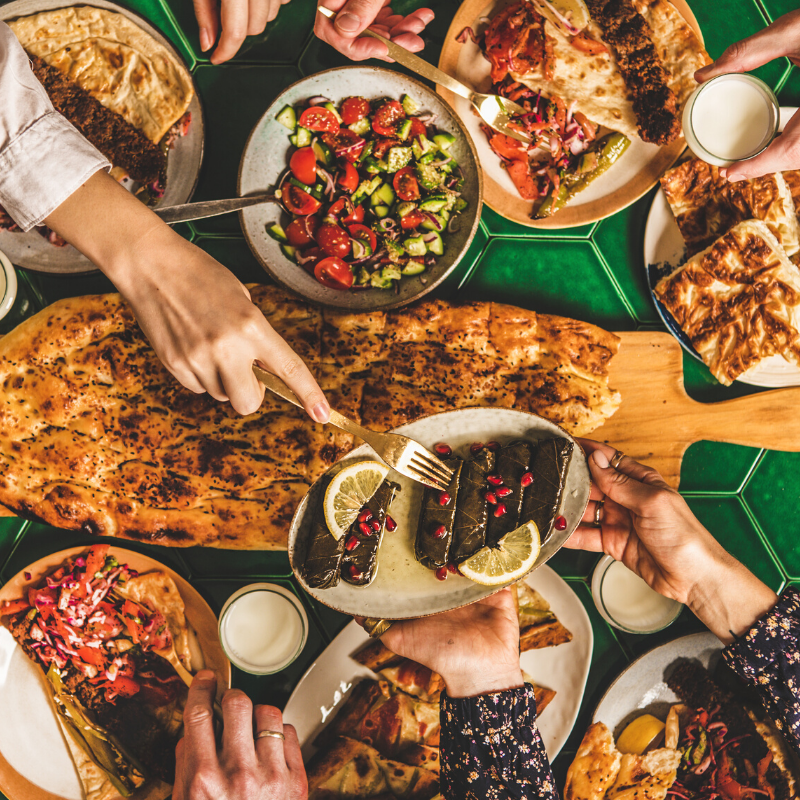
If you’ve ever been lucky enough to attend an ifṭar, you’ll know it’s an atmosphere like no other. Ifṭar meals are a time to celebrate the end of the fast with family, friends and the wider community, and some communal ifṭars feed thousands in one sitting. In Egypt, a 3 kilometre long ifṭar table set a Guinness World Record in 2019!
Arabic learners may recognise the root letters of ifṭar, ف – ط – ر , which are also found in the standard word for breakfast used during the rest of the year, فطور (futūr).
Ṣawm | Fasting | صوم
Fasting between dawn and dusk is one of the religious obligations of Muslims during the month of Ramadan. From sunrise until sunset, healthy adult Muslims must abstain from eating, drinking and smoking as an act of worship. Just before dawn, a meal called suhūr is eaten, which is the last food or drink of the day until the ifṭar meal after sunset.
Ṣā’im/a | Someone who is fasting | صائم\ة
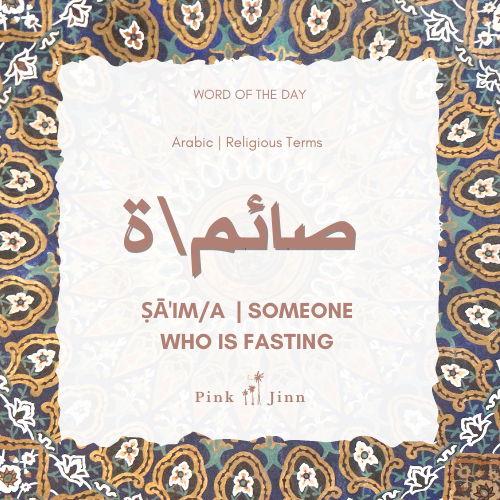
In Islam, those who are able fast between dawn and dusk during the month of Ramadan, but not all Muslims will fast every day of the month – there are exceptions from the duty of fasting including for those who are acutely ill, breastfeeding, menstruating, or have a chronic condition like diabetes.
Just a touch of Arabic grammar here – the Ism Fa’il form of the word صوم (ṣawm, or fasting) is what gives us ṣā’im/a, the word for someone who is fasting. If you’re learning Arabic, don’t miss our Instagram account focused on Arabic for more vocab, cultural insights and an amazing community of fellow Arabic learners!
Zakāt | Almsgiving | زكاة
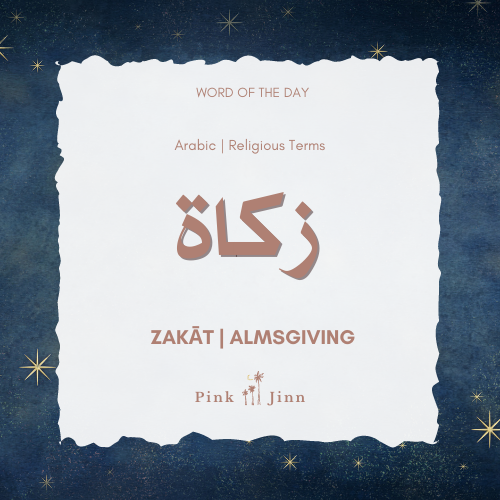
The giving of alms is another of the obligations of Muslims, especially so during the month of Ramadan. Each year, Muslims with money to spare (this threshold, called nisāb, is set by Islamic scholars) give a proportion of their personal wealth to those in need.
In some countries like Malaysia, Saudi Arabia and Sudan, zakāt is a legal obligation and contributions are collected by the state.
However in most places giving zakāt is voluntary and you can direct the money where you choose. In Islam, giving zakāt purifies your wealth just as offering prayers purifies your soul.
Sajādat a’ṣalā | Prayer mat | سجادة الصلاة
Most Muslims use a prayer mat for their daily prayers – it provides a clean and focused space for their worship. No matter where in the world they are, Muslims pray facing Mecca and prayer mats are laid on the ground in that direction. Most rugs have a top and bottom, with a pattern which points in the direction of prayer. Many are decorated with beautiful Islamic geometric motifs, or images of the Ka’aba in Mecca, or the Al Aqsa Mosque in Al Quds (Jerusalem).
The word for a prayer mat comes from the root (س ج د or S – J – D), which gives us the verb ‘to bow down in worship’, and the word for worshipper is سجاد (sajād). Did you know that Oriental Orthodox Christians also use prayer mats?
Call to prayer | Ādhān | أذان
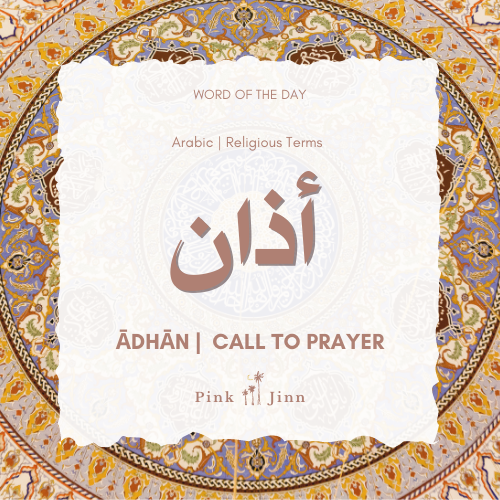
The adhan is the call to prayer you’ll hear ringing out from mosques five times a day to call worshippers to prayer.
During the worst days of the pandemic, some countries like Kuwait, Saudi Arabia and Malaysia changed the text of the adhan, replacing ‘come to prayer’ with ‘pray in your homes’.
Arkān al Islām | The Pillars of Islam |
أركان الإسلام
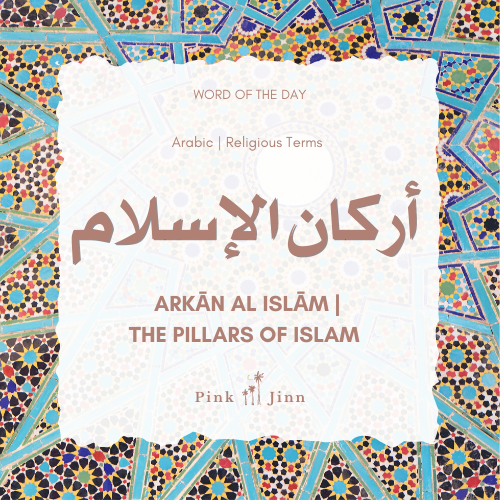
There are five pillars of Islam that Muslims must perform as obligatory acts of worship:
- Shahāda – الشهادة – Declaration of faith
- Ṣalāh – الصلاة – Prayer
- Zakāt – الزكاة – ِAlmsgiving
- Ṣawm – الصوم – Fasting
- Ḥajj – الحج – Pilgrimage
In the Twelver tradition of Shia Islam (approximately 85% of Shia Muslims), there are five additional obligatory practices, together known as the Ten Ancillaries of the Faith, or the Ten Obligatory Acts, or فروع الدين in Arabic.
Qamr a’ Deen | قمر الدين
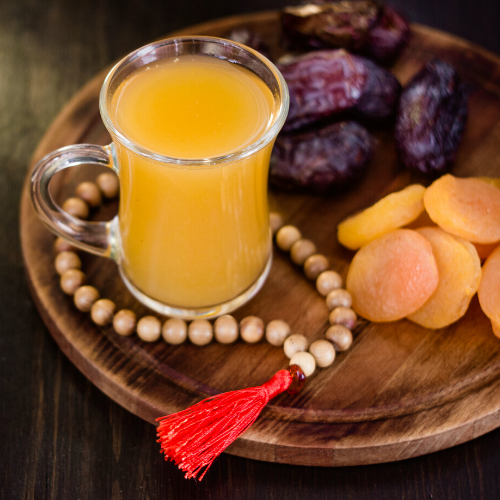
The prize for the most beautifully named drink in the world goes to… Qamr a’ deen, a thick, sweet and incredibly refreshing juice made from dried apricot paste and orange blossom water whose name means ‘Moon of the faith’.
Originally from Syria, this delicious treat is absolutely perfect for breaking the fast and is incredibly popular during the month of Ramadan.
Qamr a’ deen is just one of the options on offer though; Ifṭar meals really don’t skimp on delicious drinks and as well as the cult-status Vimto and qamr a’ deen, there’s almost always a big jug of tamr hindī, tamarind juice. Tamr means dates, and hind is the word for India in Arabic – so ‘Indian dates’ gives us tamr hindī, tamarind!
Qatāyef | قطايف
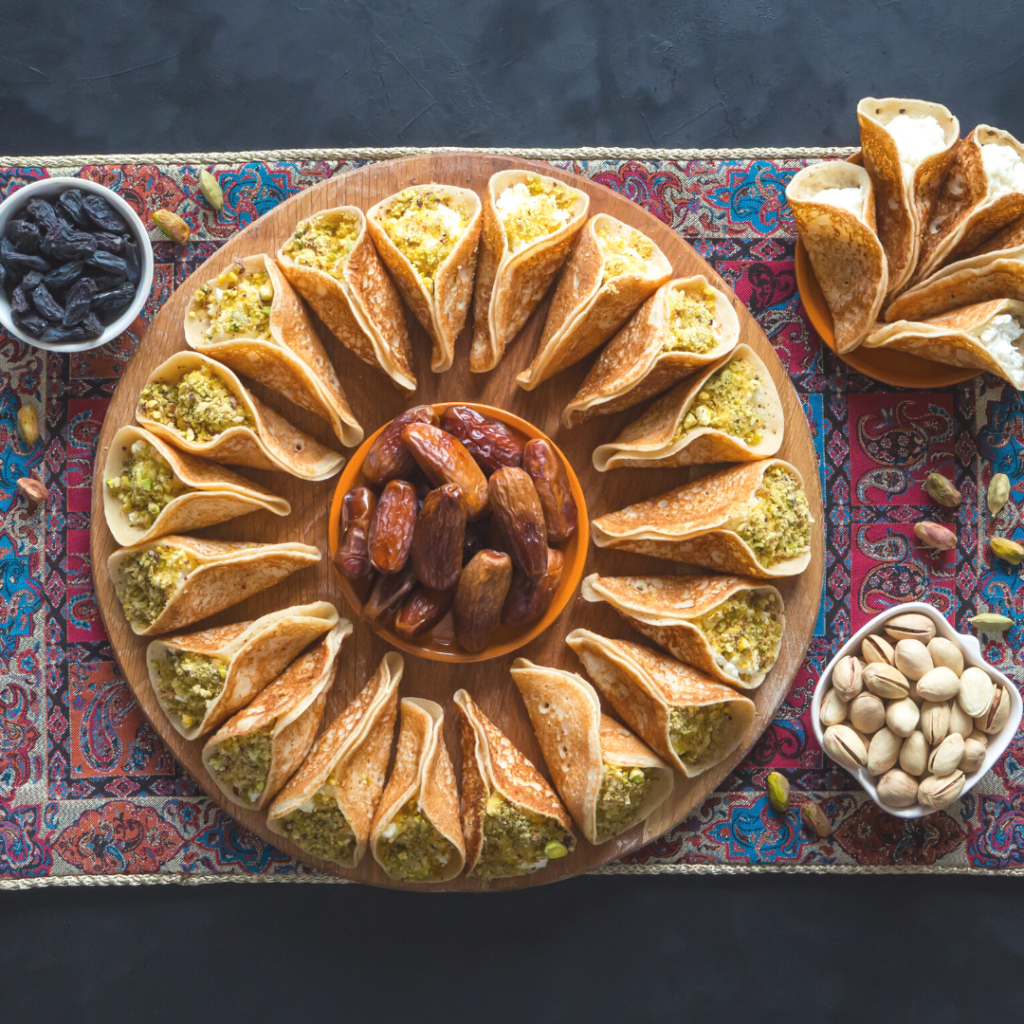
Qatāyef are tiny pancakes typically prepared during Ramadan which can be filled with all manner of deliciousness, from cream, pistachios and honey to modern versions filled with Biscoff spread or Nutella! Qatāyef can be folded into different shapes – one of which is known as Qatāyef ‘asāfīrī. ‘Asfūr are little birds or sparrows, and so the name alludes to the folded shape of the little pancakes, which are said to look like birds’ beaks.
Lailat al Qadr | The Night of Power | لیلة القدر
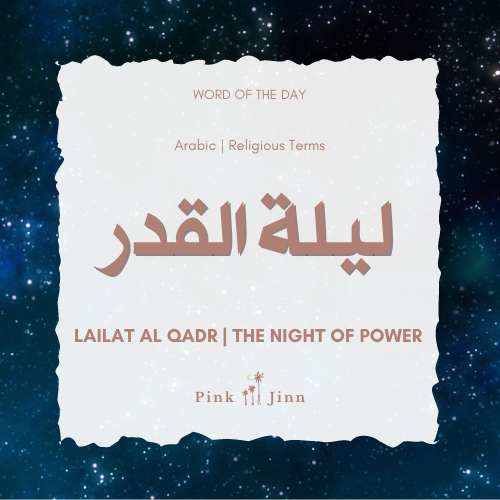
Lailat al Qadr, or the Night of Power, is celebrated as the first night that the Qur’an was sent down to Earth. The date of Lailat al Qadr isn’t fixed, it takes place on an odd-numbered night during the last 10 days of the month of Ramadan. Considered the holiest time of the year, Lailat al Qadr is a night of mercy and forgiveness from God, when prayer is amplified and blessings are abundant.
Ma’mūl | معمول
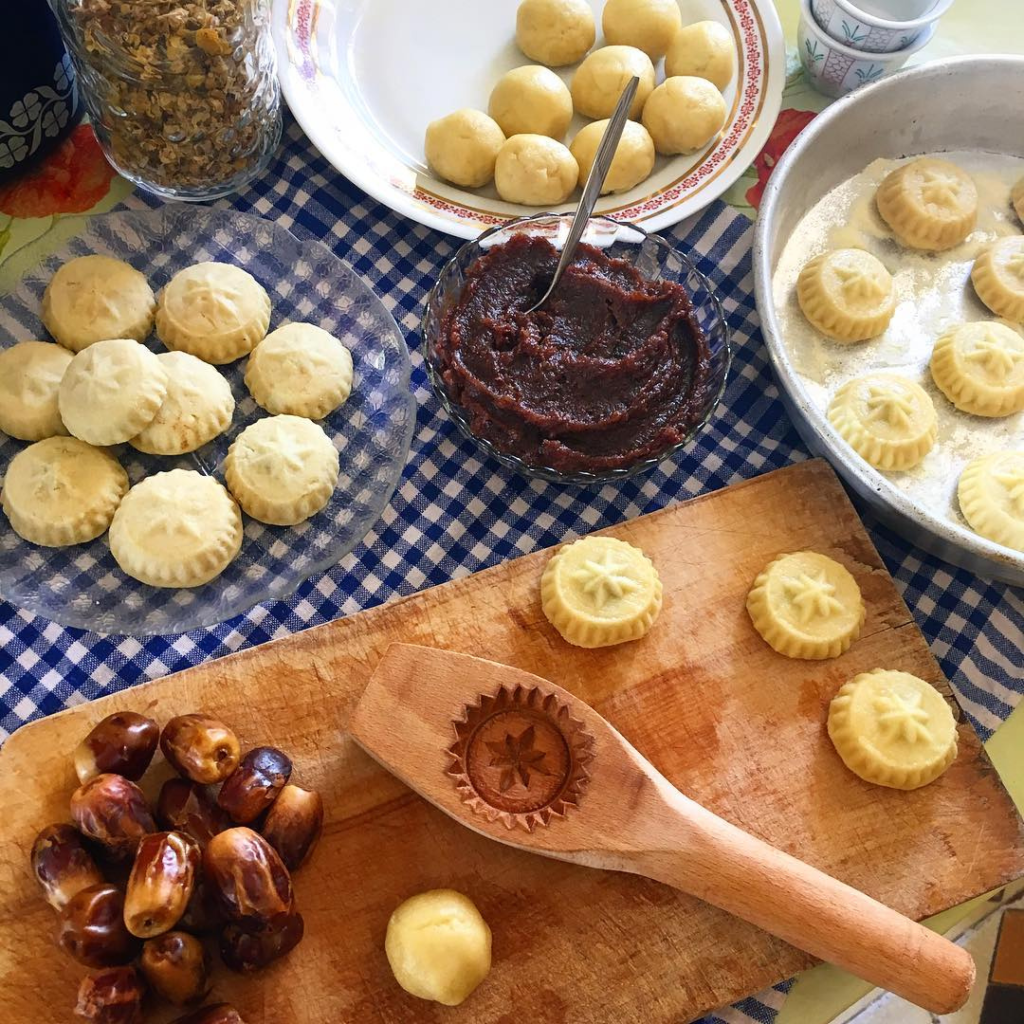
A delicious biscuit traditionally made to celebrate Eid al Fitr, ma’mūl are an almost shortbread-like biscuit, filled with a paste made of spiced dates, figs or nuts.
The filled balls of dough are formed into beautiful shapes with intricately carved moulds to make the perfect sweet treat to celebrate the end of Ramadan!
Eid Mubarak! | Blessed Eid! | عيد مبارك
Muslims across the world celebrate the end of Ramadan when the new moon is sighted. Eid al Fitr translates literally to ‘the festival to celebrate breaking the fast’. Eid al Fitr is a glorious celebration, full of decorations, beautiful lights, lavish feasts and gatherings with friends and family. Typically, new clothes are worn to celebrate, charity is given to the needy, children are given gifts and special prayers are performed.
Wishing everyone celebrating this month a joyful and generous Ramadan from Pink Jinn!
If you’re learning Arabic, make sure to follow our dedicated Arabic account on Instagram, @pinkjinnarabic, and we also have a private Facebook group especially for Arabic learners. Join here to be part of our supportive learning community – it’s open to all levels and dialects!
If you liked this article, you may also like:
The Secret World of Tatreez: From Orange Blossoms to the Nakba
Dive Into The World Of Arabic Coffee
Which Arabic Dialect Should I Learn? Spotlight On Levantine Arabic






